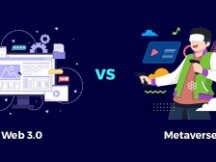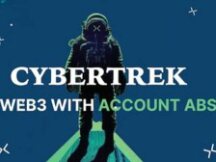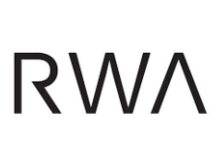How big is Web3?
While Web3 is not yet fully licensed and self-explanatory, that doesn't stop the recent discussion on Web3 from escalating further. The author of this article, Jarrod Dicker, recently made a comparison between Web3 and Web2 on his Twitter account.




Jarrod Dicker is well known in the digital media world. He was named one of Business Insider's 30 Most Qualified People of the Year in 2013. Dicker joined The Washington Post in 2013 as vice president of innovation and development. newspaper to achieve the eight-figure work rate was effective and yet profitable for the entire second year. In early 2018, Decker announced that he would be joining blockchain startup media Po.et, which had become a hot topic in the industry at the time. From Dicker's point of view, Web 2.0 and Web 3 represent changes in communication and business models, respectively.
The main purpose of the early Internet was to provide users with the same benefits that we often refer to as Web3 today. Can we look at the first developments of the Internet and give us information on the future of Web3? In the 1990s, Internet enthusiasts encountered various issues, such as configuring the modem, installing drivers, and using the Find Server command. Each of these steps is problematic and requires self-management to overcome the problem. The early internet, as it is today, made it easy for people to step out of their comfort zones. The similarity with Web3 is negligible.
Blockchain commentators like us often see this decline as a precursor to optimism. The evolution of the Internet has proven that the difficult problems of attracting more users can be overcome successfully. However, while these comparisons seem long overdue, they cannot be tested immediately. Early adopters often don't pay much attention to how they understand and access the Internet. In the early days of the Internet, this functionality emerged from online services, especially America Online.
It's hard to imagine how confusing the computer was for most people in the mid-90s, let alone the Internet. In 1997, only 35% of American households owned a computer. For many early adopters, the cost of the Internet, usually email, is very attractive. However, “accessing the Internet” is so difficult and time consuming that it often requires assistance. This is why online services come into play.
The first online services were launched in the 1980s, long before the Internet was commercialized. These services include chat, newsletters, newsletters, and other text-based UXs, but most users can only send emails with other users of the same service. . After the internet became a hub in 1992, online service providers such as DELPHI, Compuserve and Prodigy and independent ISPs gave users better access to the world. They are a little more successful.
America Online is the most difficult of all. The history of the company dates back to 1983 when it brought games to Atari, then Commodore 64, and then partnered with Apple to provide online services. In the early 90s, the company decided to adopt a new concept in order to offer unskilled workers the most convenient way to connect to the Internet. In retrospect, this decision seems obvious, affecting all of American Online's product design and marketing. But only if you think the Internet is a big deal that big business needs. At the time, it was not unreasonable. The internet has been a powerful tool for business users, and their submission strategies have influenced this. People have reason to believe that the Internet is not very easy or can be done easily.
American Online is taking the other side of the gamble, taking risks like stupidity or going against the imagination of Internet users over time. If that could eliminate or reduce the level of online access, they would. Marketing expert Jan Brandt led some of the most dangerous product distribution campaigns in history when it was discovered that restricting access to American online software was hampering growth. “Once upon a time there were 50% of CDs in the world bearing the AOL logo. We have a new user every 6 seconds. Then, in 1996, they preloaded the software in Windows 95. When companies tested that users wanted buttons like buttons, all key UX controls were given bevels and shadows.
All design and operation is optimized for performance and user engagement. American Online has an extensive 1-800 network in place so that your modem can find a landline. They preload multiple images from disks so users don't have to wait for images to load while in use. Ted Leonsis ran the Steve Case Company in 1994 and decided on many of these ideas. He once said, “I spend my time making things easier. No more vocal praise from users logging into the server again. A more famous and worthy example. It was announced with four simple words: “Mail! "

These measures really worked! From 1993 to 1996, American Online users grew from 300,000 to 8 million. For the first time in Internet history, a business has reached 'the ladder'.
The saying "It's easy to use and it's no exaggeration to say it's number one" is very true. When AOL.com launched its browser, it was by far the biggest website, not because it was interesting, but because it was the default browser. Then American Online did a lot of damage to the online community, and the price went up to a flat rate. (The fixed price was so popular that the company's designs were adopted, and state attorneys forced AOL to rescind the “Jetsons” pricing announcement.) By 1998 America Online had taken over all of its competitors. , including Netscape. America Online's vision - for convenience at all costs - has come true.
Now that we have blockchain technology, how popular will it be compared to America Online's stage of development? For consumers, the difficulty in accessing encryption services compares favorably with the advent of the internet in the early 90s. There are now two great companies that you can recommend to your non-crypto friends. Dapper and Coinbase. However, we are still in the pre-consumer phase of Web3. There are games related to special interests (see Axie) and Web3 that capture a small number of users, but there are also downsides to the intuitive and intuitive process. Most of the accessible data, such as digital toys and investment tokens, is minimal. The value of America Online is that it develops new users in a way that shows the Internet can be available at all levels. Currently, the blockchain protocol and enterprise products are not user-based. The conclusion is as follows.
"America Online's solution is also unsuitable for newbies who want to quickly and easily understand the beauty of blockchain."
We know this statement will cause an uproar from crypto-skeptics and their fans. Skeptics will say this comparison makes no sense, at least for now, due to the lack of effective encryption like email, instant messaging, or website browsing. From this point of view, it doesn't matter how easy it is to get into a "blockchain" unless there is an urgent need for most people. On the flip side, crypto enthusiasts would say the crypto community is slowly tackling a problem that's hard to get started. After all, the nature of decentralization does not accept a solution.
These objections may not be contradictory, but they are true. It is not difficult to see how they would step in to restrict trade. Decentralization makes it difficult to implement and leads to a small number of savvy crypto users resulting in a small number of users. And with the departure of the early days of the internet, the huge amount of money around the blockchain caused this "problem". In other words, it is good that cryptocurrency providers serve a small number of wealthy people and good customers. These crypto providers don't have to face the problem of getting new users.
So it will be interesting to consider what Steve Case, Ted Leonsis and Jan Brandt are currently building on the blockchain. First of all, I can assure you that the focus is on DFTs. Why? Although we are in the early stages of development, collecting and marketing "products" are more aesthetic to consumers and more suited to everyday life than abstract "money".
Consider the resources for the interests of work, sports and health. In each category, the users can buy, but they are the main "of customers such as a fashion, play group, the program Digital Services (eg Podcasts or Folders) in Shoes or Foods) or Offline Arts. These can be the NFT known. These can call yet another name. If you bought a nft, you can access the communities of others with NFT. Thinking of the company and fear, Nature activity and community activities. All nfts have from the user stored in personal information (Bags). They can choose to to the users to see their friends. If they are the world-world, the potential options them. In this case, NFT will be the bottom of the garment. If the user is satisfied with objects or loss costs, it will be sold nfts that can be easily maintained by the interface. The most important indicator indicates that the user will notify the customization of private customization and may need or be required or business.
Most of these thoughts today have slower in a large community encryption. The goal is to change from the PFP. The chat room was moved to the neighbors who are involved in Dao in the communication center. Payment and purchases are easy and provides interactions that you can buy and store online. Road will be in the people hands, and you can create a value and the contract rules for the developing trends around the spread of contamination. Of course you are the first model joint and community, but it depends on wherever you can do a trip, not a particular place. This is a new internet. For ten years, we believe the value of virtual products does not look like space, and the Internet is continuing to the real management of real-world management. This situation has been changed to the NFT. It was only all in the real world as the digital world, but now it is online. And this change is important.
America Online by Web3 will break this new trend in every way. Just as Web2 introduced ordinary Internet users, now we need to work together to prove the benefits of Web3. Please keep in mind that the world of crypto is no longer a distributed, chaotic, high-risk world, but a fun one. We only provide reasonable prices and services without fraud. We can also offer money back guarantee to dissatisfied customers!
The team behind this effort will be ruthlessly attacked by the crypto community on the basis of security risks and “centralization”. In fact, they are more likely to be attacked than Steve Case, Jan Brandt, and Ted Leonsis. We can see that the content of this concept is not only a unique product, but that a solid product can come from big platforms like Facebook, Amazon and Apple. After all, the platform's success won't last as long as kids will think their bike training can be frustrating and even embarrassing after a few months.
However, the need for blockchain development has now become a reality. Is there a way to continue? Is there something like a 3.5 inch floppy disk that requires every American in the exchange to ask for an email address? Let’s think a little more. I've always believed in having the courage to try.

Scan QR code with WeChat






























